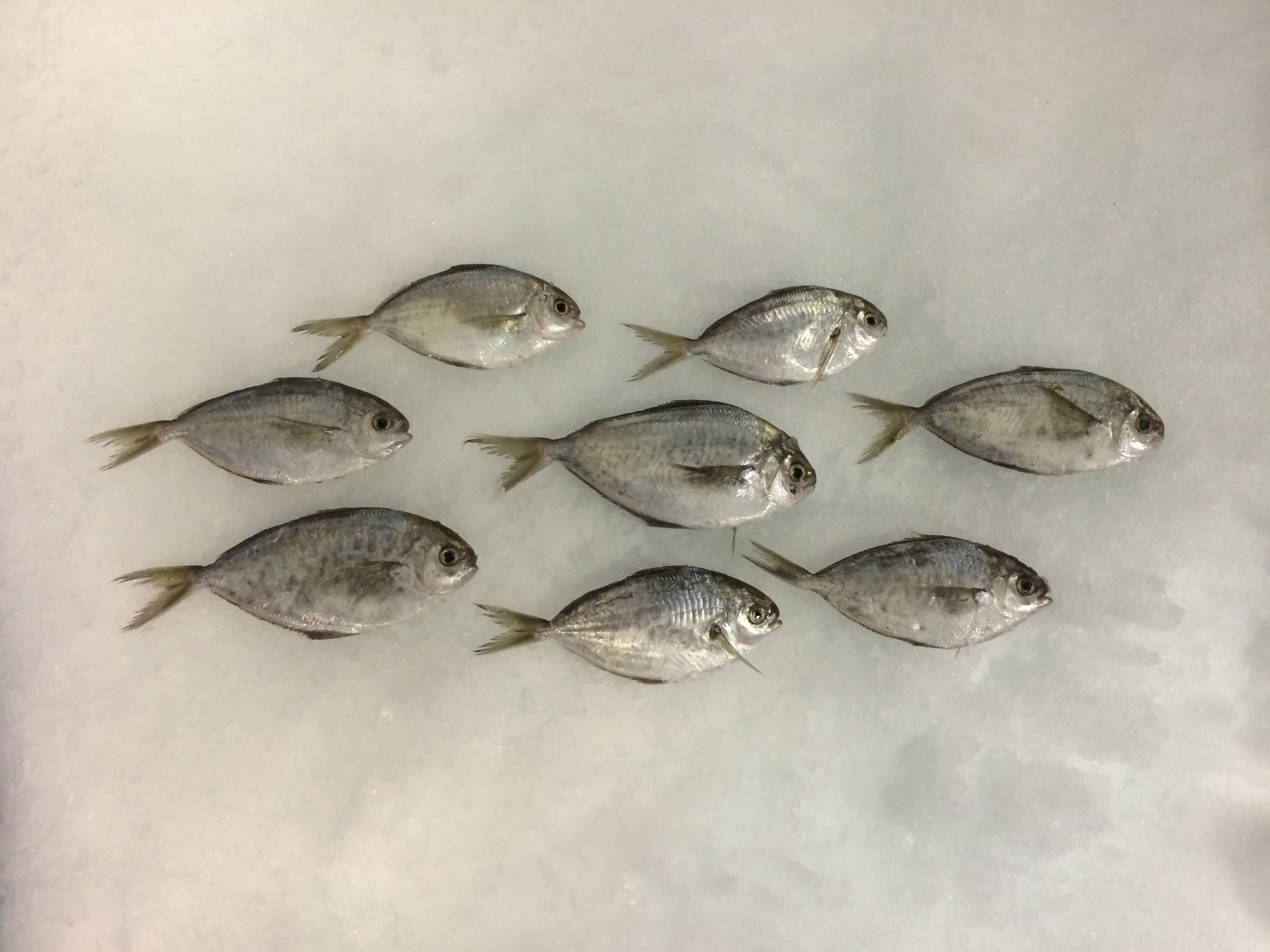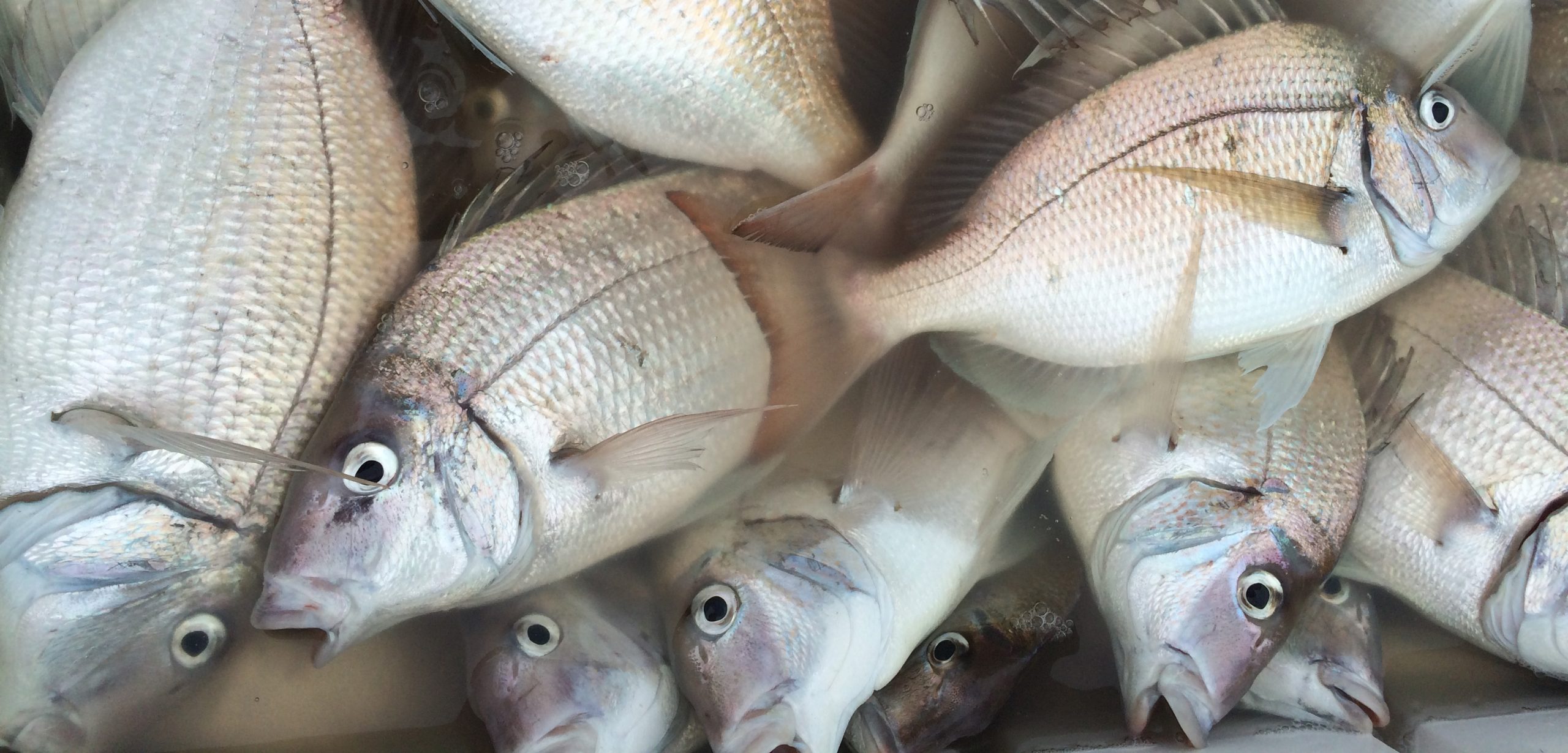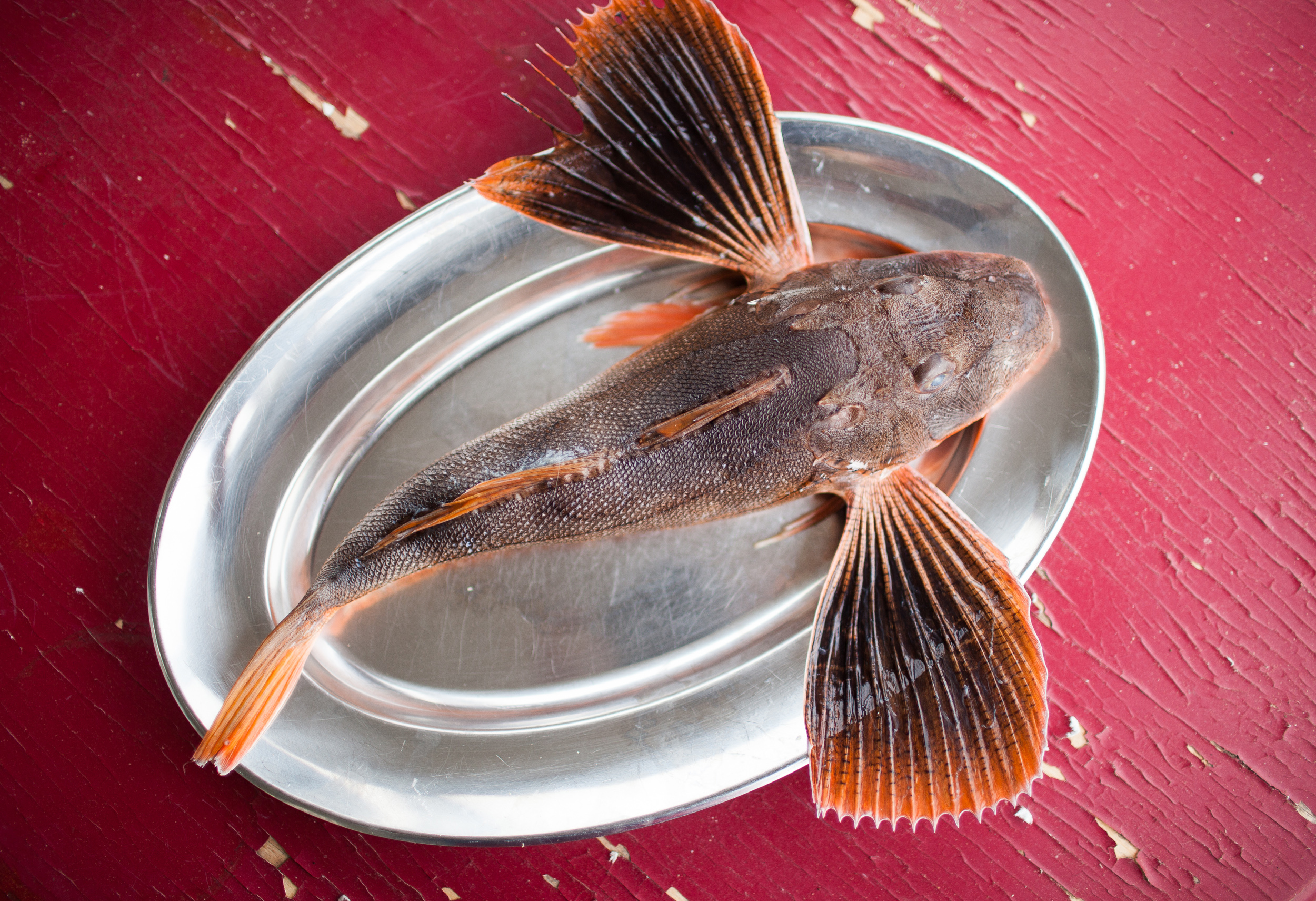Other Fish to Fry
As stocks of premium fish come under increasing stress from the growing human population, inventive chefs are cooking down the food chain, finding new uses for less-desirable fish. Is this the future of sustainable seafood?
Article body copy
There are eight words that make a food writer tremble. They are spoken a little while after the writer has taken a seat in a restaurant far beyond his means. He peruses the menu and, hoping for an early night, picks out something light and simple. But before he can order his modest dinner the server whisks the menu out of the writer’s hands and speaks those eight words—graciously, of course—but with the air of a threat: “Chef would like to cook for you tonight.”
So began a meal one stormy October evening at Dan Barber’s restaurant, Blue Hill at Stone Barns, close to New York City. That a long, weird food march was in store is not surprising. As one of the few chefs ever listed among TIME magazine’s 100 most influential people, Barber, author of The Third Plate, is an endlessly inventive kitchen master, tirelessly working and reworking his ecological concepts on the former Rockefeller estate turned farm-to-table mad scientist laboratory. For years Barber has gained admirers that range from former United States vice president and climate-change warrior Al Gore to The New York Times restaurant critic Pete Wells, who recently gave the restaurant a glowing review both for the quality of food and for the chef’s determination to cook with a smaller footprint.
Yet this was not to be the usual “prisoner-of-chef” scenario where a lord of the kitchen rolls out expensive product flown in from the far corners of the world. No, what chef Barber wanted cooked for me this night was a grand experiment in low-end seafood. Over a meal consisting of 15-odd courses, I, along with the marine ecologist Carl Safina, would sample three profoundly ignored fish: northern porgy, sea robin, and Atlantic butterfish.
As recreational fishermen used to classier catches, Safina and I regarded these fish as unimpressive, by-catch, or bait. But our other dining companion that evening, Sean Barrett, the co-founder of a new community-supported fishery called “Dock to Dish,” thought otherwise. Barrett had supplied Barber with the evening’s fare from boats out of nearby Montauk, Long Island, and he believed that these creatures deserved to be at the avant-garde of culinary America.
It was both a noble and trendy approach to dinner. Overfishing concerns for traditional target species such as tuna and cod have inspired high-end chefs to partner with fishing communities in need of something to bring to market. Together, they promote fish that might be typically ignored or, worse, caught accidentally and tossed overboard dead.
The American non-profit Chefs Collaborative, a national union of politically engaged chefs, has gone so far as to create a coast-to-coast “trash fish” dinner series that, to date, has featured unorthodox species in 40 different restaurants. For writers like me who cover sustainable seafood, the “underutilized” fish option offers a seductive check-the-box suggestion whenever we’re asked the inevitable question by readers: “What should I eat from the sea?”
But as I moved through plates of unknown fish at Barber’s Blue Hill, the questions around the sustainability of eating trash fish piled up. Trying something new is generally seen as a good thing, something we adults always encourage our children to do. The question is, are we mature enough to handle the considerable environmental responsibilities that come with bringing a new wild animal into our larder?
What’s in a Name?
The first fish to arrive was the northern porgy. The porgy is a spunky, silvery, plate-shaped fish, more known to fishermen than to the general public. Given a choice, most Americans will pick the similar (and much more expensive) farmed European sea bream instead. But the porgy’s flesh is white and flaky and every bit as tasty as the European variety. As the whole grilled animal came to the table, Sean Barrett beamed with the success he’d had in the past year taking advantage of the name of the fish’s foreign cousin.
“All the top restaurants—all of them—want our ‘Montauk sea bream’!” Barrett exclaimed.
Carl Safina raised an eyebrow, “If it’s a porgy, why not just call it a porgy?”
“People grimace at ‘porgy,’” Barrett said, “but they love to order Montauk sea bream. And when you look on Wikipedia it says right there that porgy is a kind of sea bream.”
Referencing Wikipedia is, of course, not referencing a scientific tome. But there’s some taxonomic truth here. Both the northern porgy and the European sea bream belong to the same family, Sparidae. But, then again, chickens and turkeys also share a taxonomic family, as do sheep and cows. And the point Safina was making about calling a porgy a porgy comes from a place of deep negative experience. Patagonian toothfish, Atlantic goosefish, and red drum all thrived as relatively unknown species until they were rebranded respectively as Chilean sea bass, monkfish, and redfish. Today toothfish are subject to some of the worst illegal fishing pressure in the world. Goosefish have only recently recovered from a pummeling they took during the 1980s. And red drum became scarce in the 1970s, yet gained such a following after New Orleans celebrity chef Paul Proudhomme prepared them as “blackened redfish” in the 1980s that you are now as likely to find them growing on farms in China as swimming in the wilds of Louisiana.
But things are different in American fisheries now than they were when fishermen rode roughshod from species to species with tragically little oversight and with the complicity of the eat-more-fish message touted by the US Department of Commerce in the 1970s and ’80s. Ever since the passage of a revamped Sustainable Fisheries Act in 1996, we have been in a regulatory regime where commercial species must have a management plan and where overfishing is lawfully discouraged. That regime means that not only targeted catching of porgy has to be limited but also accidental by-catch. Because baby porgies often school with squid, squid trawling vessels with their fine-meshed nets used to accidentally scoop up juvenile porgies on a massive scale. Now, however, thanks to the implementation of what are called Gear Restricted Areas, or GRAs, fishermen mostly keep squid trawlers out of sensitive porgy habitat, helping the recovery.
So porgies are, indeed, now quite abundant. Will they stay that way if they become “Montauk sea bream” and the public gobbles them up with relish? One would hope so. But as market prices rise with reputation, rules have a way of bending. As the noted fisheries scientist Ted Ames said to me a few years back, “never stand in between a fat hog and a trough. He’ll run you over every time.”
A Bird With No Plan
Speaking of fat hogs, we were heading in that direction as course after course paraded from Dan Barber’s kitchen. They included three varieties of home-churned butter spread on Barber-bred whole wheat bread; tiny chili peppers whose hot bite had been selected out of their genome by plant breeders at Cornell University; and an egg (from a pasture-raised local chicken) poached using the heat generated from a compost pile.
And so it was with a bit of trepidation that we greeted fish number two. This one was called a sea robin—or as Sean Barrett was trying out in his Dock to Dish marketing material, “Atlantic gurnard.” Safina and I were familiar with this one, too. The sea robin is an odd looking creature with a bulbous, bony, brown head that accounts for more than half of the fish’s weight. Bird-like “wings” allow it to hover over the sandy sea floor and suck up clam and squid, species people use to catch more-desirable fish like flounder and fluke. In Europe, gurnards are commercially pursued but, with their many bones, they usually end up as the murky base of a bouillabaisse. Back home on Long Island, when I catch a sea robin I generally throw it back and mutter, “Ack the bird, the bird.”
Here, the bird was presented headless, a ball of meat still affixed to the spine with an auburn tail rising attractively out of a pool of tan chowder. It was quite delicious. It was also pretty much impossible to tell whether or not it qualified as being sustainable.
In the United States and several other progressive fishing nations, it’s the law that commercial fish and shellfish be assessed and managed in such a way that their population remains stable over time. But here’s the rub: sea robin and many other so-called “trash fish” are not yet really defined as commercial species in the United States. For sea robin, no population estimate exists. No management plan has been drafted. And while sea robins are anecdotally abundant, there’s no guarantee they will stay that way. As Safina, one of the major intellectual forces behind the 1996 Sustainable Fisheries Act, wrote me a few months after our dinner, “If it doesn’t have a management plan, it shouldn’t be allowed to be sold.”
Even if a fish species is deemed worthy of active commercial management, incomplete data on population sizes and reproductive rates is a shockingly widespread problem. When I interviewed the director of the Fish and Game Department for California (arguably the United States’ most progressive fisheries state), I was surprised to learn that only a few stocks out of the dozens of fish populations the state oversees have a formal management plan. And when I asked Michael Weber, the author of a comprehensive history of American fisheries called From Abundance to Scarcity, if anyone had ever undertaken a cost-benefit analysis for bringing all American fish stocks into adequate assessment and appropriate management, he laughed. “There was a report written,” Weber told me, “but the cost to do all that was so great that [the people associated with the report] buried it.”
Fish or Eat Bait
And still the “sustainable” food kept coming. A rack of upright baby carrots, sweet as sugar, delectable down to their green, springy tops. A tiny burger grilled over lobster-shell biochar. A whole pig skull adorned with some kind of meat wrapped in lettuce rolls. “What’s this?” I asked, as I sucked one of them down.
“Oh that?” the waitress said smiling, “that’s eye socket.” Technically, it was the eye socket muscle.
When our stomachs started to bulge and our legs grew numb, we were led from the table to a tiny room that had at one time been the manure shed but had since been carefully appointed with table settings for three and a meat slicer. Upon our arrival, a sous chef placed a whole kohlrabi root on the machine and shaved off paper-thin vegetable wrappers. These we filled with wedges of succulent flesh derived from the last fish of the night—a palm-sized little charmer known as a butterfish. Once again, Safina and I recognized an old friend. But unlike the previous two fish, neither of us had ever caught a butterfish. We had instead used butterfish as bait to catch other fish.
The amount of fish that is either used as bait or to feed farmed fish is so great that I’m surprised no one has yet attempted to break a story under the headline “Bait-Gate.” Herring, sardines, anchovies, and, yes, butterfish, all used in other countries as table fare, are, in the United States and Canada, traditionally used as bait to catch other species. And they’re not just bait for other fish; 80 percent of the Maine herring catch ends up in traps for lobsters. What doesn’t get used for bait generally gets ground down into fertilizer or rendered as pellets and oil and then is fed to farmed salmon.

Traditionally bait for big fish like tuna, butterfish have made their way onto menus at top restaurants. Photo by Sean Barrett/Dock to Dish
With the butterfish, I felt Barber and Barrett had hit upon a genuine trash fish winner. For really, what business do we have, in this day and age of shrinking resources and growing populations, taking perfectly good, nutritious, wild animals and destroying them for the sake of acquiring another kind of protein that we might prefer a bit more?
Just as we started to reach the bursting point in the meal, a plate of three crackling brown triangles arrived with little tails jutting out here and there. It was the butterfish skeletons, fried to a crisp and as delectable as anything we’d eaten all night.
“I used to put whole butterfish back into the ocean and the next time I saw them they had turned into bluefin tuna,” Safina mused to me later. “I never imagined I would be eating not just the tuna bait but the parts of leftover bait that stray cats would get.”
The Takeaway
No doggie bags were sought at the meal’s conclusion. The uneaten scraps would end up in the Stone Barns compost pile where they would rot and warm and probably poach more eggs. But in the wake of so much consumption, it seemed worthwhile to take a step back and draw some conclusions from the trash fish experience. Clearly we will all be eating different fish as human populations grow. But what rules should we follow if given a buffet of potential new species to choose from? Based on what I learned from the meal, I’d suggest the following:
- If “new” fish are to be marketed under innovative new names, we should also provide transparency to the consumer so that the market name doesn’t disguise the biological identity of the fish. In New Zealand, a fish must be sold with its full taxonomic name. We might adopt a similar approach in North America. Only when we know exactly what we’re eating can we make informed decisions as consumers.
- Any “underutilized” species can quickly become an over-utilized species should trends and markets align. This pattern is so common worldwide that scientists have given it a name: “serial overfishing.” The only defense against a classic boom and bust scenario is to make sure that any fish sold be subject to a formal stock assessment and a management plan. Otherwise we are just fishing and eating in the dark.
- In addition to identifying underutilized species we should also identify poorly utilized species. The vast number of creatures known as “forage fish”—currently sold for a few dollars a ton and used primarily to feed or catch other fish—should be repurposed toward more valuable markets of direct human consumption. Again, the goal is not just to raise market value for these fish but to find an appropriate market niche that will lead us to a more respectful place.
As for chefs scanning the horizons for the next big thing, what should they do? Well, they might consider taking a page from Dan Barber’s book and look deeper for something new and cool. A few months after our dinner, Barber shuttered the Manhattan Blue Hill restaurant for a couple of weeks to open a pop-up incarnation that went even more low-end than trash fish, “devoted to food waste and reuse.”
“We’re putting a lot of interesting seafood on the menu, including skate-cartilage fries and bloodline salmon carpaccio,” Barber explained in an email. In other words, a step below trash fish. Outright trash, reinvented as food. Will this true seafood trash take hold?
Barber is bullish: “Hey,” he wrote, “those skate wing cartilages are super tasty.”
Correction: A previous version of this article misidentified the country that requires the scientific name of fish to be printed on packaging. The country that should have been referenced was New Zealand. There is currently a campaign to add this requirement in Australia.


